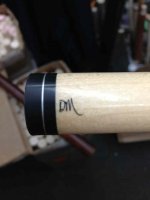Any reason why cuemakers don't sign their shafts ??
This often comes up with trying to identify original shafts,,
Reasons,,Comments ??
Thanks,,,,,,,,,,,,
Alan ,,,,,,,
This often comes up with trying to identify original shafts,,
Reasons,,Comments ??
Thanks,,,,,,,,,,,,
Alan ,,,,,,,
